Shocks & Struts - Redondo Beach
What worn shocks do (or don’t do)
SIMPLY PUT: MORE WEAR = LESS VEHICLE CONTROL
There are two major disadvantages that begin to occur as your shocks (or struts) wear. First, as the shock’s ability to resist wheel & body movement diminishes, it becomes more difficult to control your vehicle. That becomes evident as quick-stopping distances increase and the driver has to compensate for conditions like body roll and nose-diving. The second is increased wear of every other related vehicle component. Since more suspension movement is allowed as the shocks wear, every attached part is subject to additional impacts and wear to those components occurs more quickly. The suspension springs, support arms, bushings, joints and wheel alignment all suffer. That translates to a shorter vehicle life, less vehicle satisfaction and additional repair expenses. Come to Pacific Tire Motorsports for shocks & struts - Redondo Beach service today!
WHY LESS CONTROL?
Worn shocks allow more dramatic up & down tire movement. As the tire bounces up, the available tread contact on the pavement decreases. If the tire isn’t gripping the road well, you have traction loss. Cornering, accelerating and stopping can become a problem. Additionally, when you add wet or slippery conditions… well you can imagine the trouble the driver can have.
WHY MORE WEAR?
It’s a little bit like the old song: “The knee bone is connected to the thigh bone; the thigh bone is connected to…” The extra impact and movement at each attached part causes accelerated deterioration or wear. One worn part causes another… and another… and so on.
WHAT CONDITIONS?
The best way to talk about ride control conditions is to show you some examples. Actually all vehicles experience these movements or conditions to some degree. However as more wear occurs, each one finally becomes a control or safety concern. KYB developed a rating system that can be used to discuss various stages of wear.
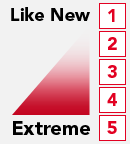 CONDITIONS RATING SCALE
CONDITIONS RATING SCALE
Use this simple guide to compare current conditions to like-new condition or the improvement that new shocks/struts would provide.
HOW DOES YOUR VEHICLE SCORE?
9 RIDE CONTROL CONDITIONS:
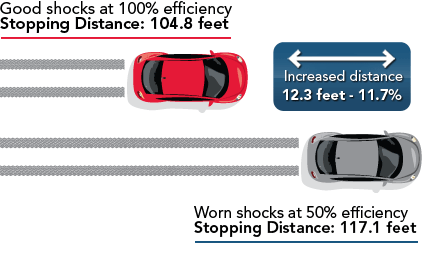
1. BRAKING DISTANCE
Panic Stopping: What if the tires can’t grip well? As shocks/struts wear and the tire to road contact becomes less effective, the vehicle can’t stop as well.
Test source RAC (Royal Automotive Club) Test No.996
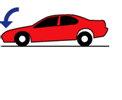 2. NOSE DIVE
2. NOSE DIVE
When you apply the brakes, the tires begin stopping but the vehicle body inertia tries to keep going forward. The result thrusts the front end downward and the back end upward. This imbalance puts stress on the front brakes and reduces the rear brake’s efficiency. The effect then makes controlling and steering the vehicle more difficult.
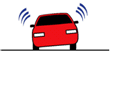 3. BODY ROLL
3. BODY ROLL
During cornering the vehicle body weight tries to lift & roll toward the outside of the turn. Controlling the weight shift or slowing the vehicle speed are the only ways to reduce the effect.
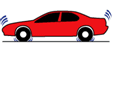 4. RIDE HARSHNESS
4. RIDE HARSHNESS
Small bumps and tire movements are transmitted throughout the vehicle. The ride can feel rough, harsh and noisy. This abrupt action affects both driver comfort and tire performance. The result is traction loss and usually along with that, less vehicle satisfaction.
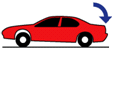 5. ACCELERATION SQUAT
5. ACCELERATION SQUAT
During initial acceleration, like when leaving a stop, the front end rises and the back end lowers. Front end rise is controlled by the rebound damping in the shock. On a front wheel drive vehicle this results in traction loss and reduces steering control.
 6. TRACTION LOSS
6. TRACTION LOSS
This can occur during braking, accelerating or cornering. When the tires can’t grip the road, for any reason at all, the result is loss of control: When the tires are bouncing or the vehicle body inertia is lifting or pushing the tires; when the tire tread is worn; when the tires are improperly inflated; or when the shocks and struts aren’t controlling tire and body movements.
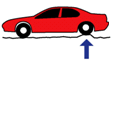 7. BOTTOM-OUT
7. BOTTOM-OUT
Reacting to a bump is normal. But when the tire is allowed to over-react and move upward too aggressively, the travel must be stopped by a cushion or bumper stop. This is an indication that either the vehicle is being operated beyond its normal ability, such as being over-loaded or being driven too harshly. Or it could mean that the shocks are worn and can no longer resist wheel movement adequately.
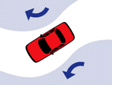 8. SWERVE
8. SWERVE
Excessive left to right or sideways movements from; wind gusts, road conditions and steering movements. The shock or strut on one side is controlling a compression (or downward) movement while the opposite side is controlling a rebound (upward) movement. Steering corrections are required and can become difficult as the condition worsens.
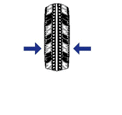 9. TIRE CUPPING
9. TIRE CUPPING
When the tire is allowed to move up & down excessively, a rhythmic movement develops and an evenly-spaced wear pattern begins. Unlike tire balance conditions, the wear pattern frequency is greater from shorter tire movements that are not being dampened by worn shocks or struts. As the condition worsens, tire noise occurs along with traction loss and of course… tire damage.